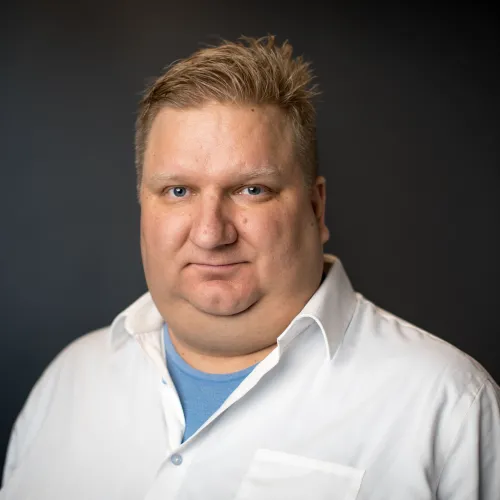Applied mathematics
The research on applied mathematics at the School of Engineering Sciences focusses on inverse problems, uncertainty quantification, numerical analysis and computational statistics. We are part of the Flagship of Advanced Mathematics for Sensing, Imaging and Modelling (2024-2031) and of the Centre of Excellence Inverse of Modelling and Imaging (2018-2025), both granted by the Research Council of Finland. Other partners of the consortia are University of Helsinki, Aalto University, University of Eastern Finland, University of Jyväskylä, University of Oulu, Tampere University and the Finnish Meteorological Institute.
Inverse problems
Inverse problems appear in several fields, including medical imaging, image processing, mathematical finance, astronomy, geophysics, nondestructive material testing and sub-surface prospecting. Typical inverse problems arise from asking simple questions "backwards". For instance, the simple question might be "If we know precisely the structure of the inner organs of a patient, what kind of X-ray images would we get from her?" The same question backwards is "Given a set of X-ray images of a patient, what is the three-dimensional structure of her inner organs?" This is the inverse problem of Computerized Tomography, or CT imaging.
Inverse problems are usually more difficult than the simple questions they reverse, and their successful solution requires specially designed algorithms that can tolerate errors in measured data. We specialise in Bayesian inverse problems, the effort to address real-world inverse problems as Bayesian statistical estimation problems, and in inverse problems for partial differential equations and geometry. We also study how statistical errors in measured data propagate to solutions.
Uncertainty quantification
Bayesian statistics recasts approximation and inverse problems in the form of statistical quest of information. Prior probabilities describe the degree of belief in different solution candidates. With the Bayes' theorem this information is updated to posterior probabilities based on observed data. Fundamental theoretical and numerical development is crucial to make uncertainty quantification feasible for the massive data sets available in applications. We develop theory, numerical algorithms and practical implementations for uncertainty quantification, with focus on inverse problems and kernel-based approximation and inference, such as Gaussian process models. Our work is highly interdisciplinary and is situated in the intersection of applied mathematics, statistics and machine learning.
Numerical analysis and computational statistics
The challenges posed by modern scientific computing and engineering call for computationally efficient and robust numerical and statistical methods. We study, develop and implement methods for statistical simulation, function approximation, numerical integration and optimisation. Our work combines ideas from traditional numerical analysis with statistics and machine learning. We have been forerunners in adaptive Markov Chain Monte Carlo (MCMC), now widely used in various applications. Adaptive MCMC methods learn from the previous model evaluations ‘on fly' and tune the algorithm as the simulation proceeds. A Toolbox is available at GitHub.
Large-scale Research Infrastructure Projects
We are involved in several large-scale research infrastructure projects:
Prof. Heikki Haario collaborates with the Finnish Meteorological Institute on weather and climate models, as well as on many satellite remote sensing projects, such as ENVISAT/GOMOS. At the moment one of the hottest topics is the OCO-2 satellite (Orbiting Carbon Observatory-2). The work focuses on mathematical methodology for enabling parameter estimation in collaboration with MIT and JPL/Caltech.
Prof. Tapio Helin is involved with European Southern Observatory, where atmospheric turbulence is a major challenge in modern ground-based telescope imaging as the turbulence (fluctuations of the refractive index) perturbs the light waves passing through atmosphere. In telescope imaging this phenomenon causes degraded resolution and blurring of the images. A good mathematical model of the atmospheric turbulence is essential in estimating how accurate imaging is possible at given weather conditions. Our research takes a reversed perspective. Consider a light wave entering the atmosphere and being observed on the ground. What information can such data provide from turbulence in the atmosphere? This inverse problem becomes a crucial challenge in the ground-based telescope imaging during the next decade.
Prof. Lassi Roininen is involved with building the next-generation 30,000-antenna fully-digital phased-array high-power incoherent scatter radar EISCAT3D. With transmitter-receiver in Norway and receivers in Finland and Sweden, and radar first light 2021, it will provide 3D volumetric radar imaging of the ionospheric plasma at altitudes 80-1,000 km. EISCAT3D can be used for space weather monitoring, lunar mapping, and space debris and asteroid detection. We develop mathematically rigorous spatiotemporal volumetric radar imaging by providing powerful supercomputing solutions for large-scale computational inversion with novel Gaussian and non-Gaussian spatiotemporal hierarchical models and full-blown uncertainty quantification.

Seminar on Computational Engineering

Flagship of Advanced Mathematics for Sensing, Imaging and Modelling
Professors



Tapio Helin

Jari Hämäläinen

Lassi Roininen
Senior scientists


Toni Karvonen

Jesse Railo

Jouni Sampo

Post-doctoral researchers










Ph.D. students









Ville-Petteri Manninen




Docents






Ph.D. candidates without LUT affiliation
- Lasse Johansson
- Theonille Mukamana
- Michel Rwema




